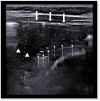Usefulness of Lung Ultrasound in Paediatric Respiratory Diseases
- PMID: 34679481
- PMCID: PMC8534634
- DOI: 10.3390/diagnostics11101783
Usefulness of Lung Ultrasound in Paediatric Respiratory Diseases
Abstract
Respiratory infection diseases are among the major causes of morbidity and mortality in children. Diagnosis is focused on clinical presentation, yet signs and symptoms are not specific and there is a need for new non-radiating diagnostic tools. Among these, lung ultrasound (LUS) has recently been included in point-of-care protocols showing interesting results. In comparison to other imaging techniques, such as chest X-ray and computed tomography, ultrasonography does not use ionizing radiations. Therefore, it is particularly suitable for clinical follow-up of paediatric patients. LUS requires only 5-10 min and allows physicians to make quick decisions about the patient's management. Nowadays, LUS has become an early diagnostic tool to detect pneumonia during the COVID-19 pandemic. In this narrative review, we show the most recent scientific literature about advantages and limits of LUS performance in children. Furthermore, we discuss the major paediatric indications separately, with a paragraph fully dedicated to COVID-19. Finally, we mention potential future perspectives about LUS application in paediatric respiratory diseases.
Keywords: children; lung ultrasound; respiratory diseases.
Conflict of interest statement
The authors declare no conflict of interest.
Figures


Similar articles
-
Lung Ultrasound May Support Diagnosis and Monitoring of COVID-19 Pneumonia.Ultrasound Med Biol. 2020 Nov;46(11):2908-2917. doi: 10.1016/j.ultrasmedbio.2020.07.018. Epub 2020 Jul 20. Ultrasound Med Biol. 2020. PMID: 32807570 Free PMC article. Review.
-
ECHOPAEDIA: Echography in Paediatric Patients in the Age of Coronavirus Disease 2019: Utility of Lung Ultrasound and Chest X-Ray in Diagnosis of Community-Acquired Pneumonia and Severe Acute Respiratory Syndrome Coronavirus 2 Pneumonia.Front Pediatr. 2022 Feb 28;10:813874. doi: 10.3389/fped.2022.813874. eCollection 2022. Front Pediatr. 2022. PMID: 35295703 Free PMC article.
-
Ultrasound detection of pneumonia in febrile children with respiratory distress: a prospective study.Eur J Pediatr. 2016 Feb;175(2):163-70. doi: 10.1007/s00431-015-2611-8. Epub 2015 Aug 19. Eur J Pediatr. 2016. PMID: 26283293
-
Lung ultrasound is a reliable diagnostic technique to predict abnormal CT chest scan and to detect oxygen requirements in COVID-19 pneumonia.Aging (Albany NY). 2020 Oct 30;12(20):19945-19953. doi: 10.18632/aging.104150. Epub 2020 Oct 30. Aging (Albany NY). 2020. PMID: 33136555 Free PMC article.
-
Lung ultrasonography to diagnose community-acquired pneumonia in children.BMC Pulm Med. 2017 Dec 19;17(1):212. doi: 10.1186/s12890-017-0561-9. BMC Pulm Med. 2017. PMID: 29258484 Free PMC article. Review.
Cited by
-
A versatile role for lung ultrasound in systemic autoimmune rheumatic diseases related pulmonary involvement: a narrative review.Arthritis Res Ther. 2024 Sep 18;26(1):164. doi: 10.1186/s13075-024-03399-2. Arthritis Res Ther. 2024. PMID: 39294670 Free PMC article. Review.
-
Long COVID in Children and Adolescents: Mechanisms, Symptoms, and Long-Term Impact on Health-A Comprehensive Review.J Clin Med. 2025 Jan 9;14(2):378. doi: 10.3390/jcm14020378. J Clin Med. 2025. PMID: 39860384 Free PMC article. Review.
-
Paediatric Thoracic Imaging in Cystic Fibrosis in the Era of Cystic Fibrosis Transmembrane Conductance Regulator Modulation.Children (Basel). 2024 Feb 16;11(2):256. doi: 10.3390/children11020256. Children (Basel). 2024. PMID: 38397368 Free PMC article. Review.
-
Point-of-care lung ultrasound predicts hyperferritinemia and hospitalization, but not elevated troponin in SARS-CoV-2 viral pneumonitis in children.Sci Rep. 2024 Mar 11;14(1):5899. doi: 10.1038/s41598-024-55590-9. Sci Rep. 2024. PMID: 38467670 Free PMC article.
-
Acute Respiratory Failure in Children: A Clinical Update on Diagnosis.Children (Basel). 2024 Oct 12;11(10):1232. doi: 10.3390/children11101232. Children (Basel). 2024. PMID: 39457197 Free PMC article. Review.
References
-
- World Health Organization Pneumonia World Health Organization. [(accessed on 20 September 2021)]. Available online: https://www.who.int/news-room/fact-sheets/detail/pneumonia.
-
- Harris M., Clark J., Coote N., Fletcher P., Harnden A., McKean M., Thomson A. British Thoracic Society Community Acquired Pneumonia in Children Guideline Group. Guidelines of the management of community acquired pneumonia in children: Update 2011. Thorax. 2011;66:ii2–ii23. doi: 10.1136/thoraxjnl-2011-200598. - DOI - PubMed
-
- Bradley J.S., Byington C.L., Shah S.S., Alverson B., Carter E.R., Harrison C., Kaplan S.L., Mace S.E., McCracken G.H., Jr., Moore M.R., et al. The management of community-acquired pneumonia in infants and children older than 3 months of age: Clinical practice guidelines by the Pediatric Infectious Diseases Society and the Infectious Diseases Society of America. Clin. Infect. Dis. 2011;53:e25–e76. doi: 10.1093/cid/cir531. - DOI - PMC - PubMed

